Physical Address
304 North Cardinal St.
Dorchester Center, MA 02124
Physical Address
304 North Cardinal St.
Dorchester Center, MA 02124
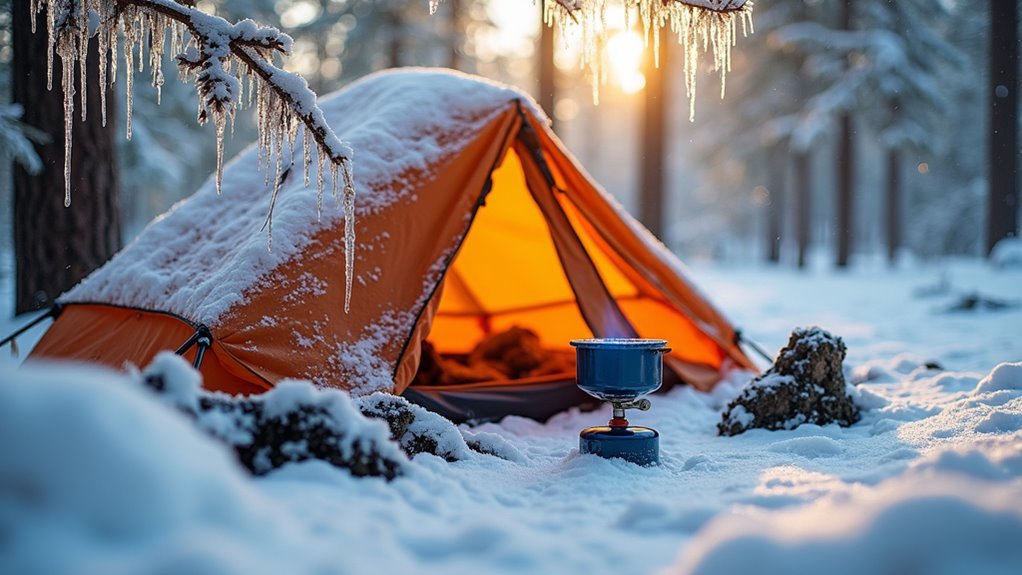
Uncover the hidden winter camping dangers that transform serene snowy escapes into life-threatening ordeals beyond just freezing temperatures.
You’ve probably imagined winter camping as a peaceful escape into a snow-covered wonderland, but the reality includes serious risks that can turn your adventure into a survival situation. Cold temperatures aren’t just uncomfortable—they’re potentially deadly, and that’s only the beginning. From equipment failures when you need gear most to invisible threats like carbon monoxide, winter’s beauty masks dangers that catch even experienced campers off guard. Here’s what you’re really up against.
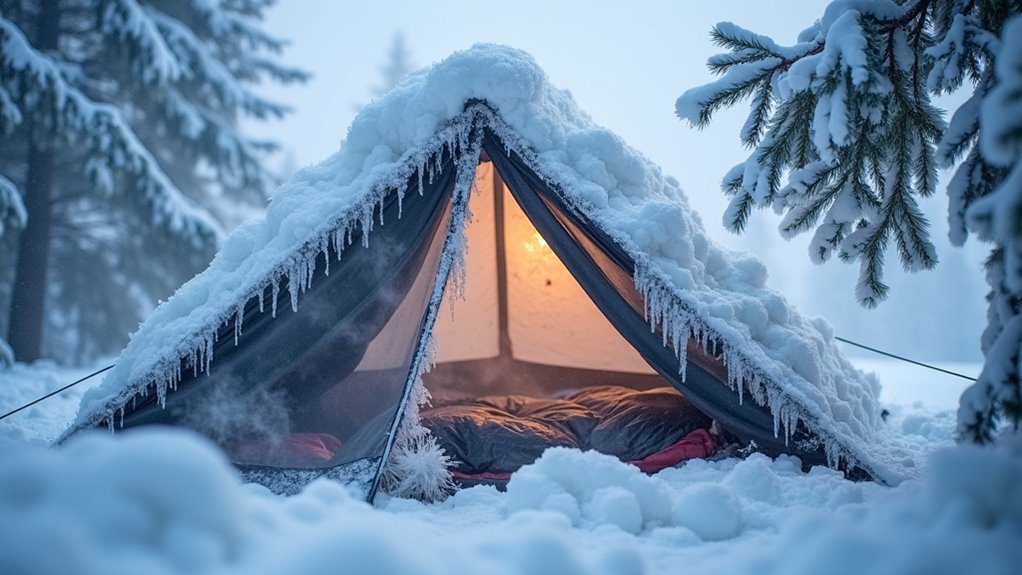
When winter camping, your body’s core temperature can drop to life-threatening levels faster than you’d expect. Hypothermia occurs when your internal temperature falls below 95°F, causing confusion, uncontrollable shivering, and loss of coordination.
You’ll recognize early signs: intense shivering, clumsiness, and difficulty speaking clearly. As it progresses, you’ll stop shivering entirely – a dangerous indicator that your body’s warming mechanisms are failing.
Prevention’s your best defense. Layer moisture-wicking clothing, keep dry spare clothes accessible, and consume high-calorie foods regularly. Don’t ignore fatigue or cold symptoms.
If hypothermia strikes, get the victim into shelter immediately. Remove wet clothing, provide warm drinks if they’re conscious, and use body heat for gradual rewarming.
Severe cases require immediate evacuation and medical attention. Learning from common backpacking mistakes can help you avoid dangerous situations that lead to hypothermia in the first place.
While hypothermia affects your entire body, frostbite attacks specific areas where blood flow becomes restricted in freezing conditions. Your extremities—fingers, toes, nose, and ears—are most vulnerable since your body prioritizes warming essential organs.
Your body sacrifices blood flow to extremities during freezing conditions, leaving fingers, toes, nose, and ears defenseless against frostbite’s targeted attack.
You’ll first notice frostnip, where skin turns red and feels cold, then numb. This stage is reversible with proper warming. However, superficial frostbite creates blisters and turns skin white or pale. Deep frostbite affects all skin layers and tissues below, causing permanent damage.
Prevent frostbite by keeping extremities dry and warm. Wear moisture-wicking layers, waterproof gloves, and insulated boots. Don’t ignore early warning signs like tingling or numbness.
If frostbite occurs, warm the area gradually with body heat—never use direct heat sources like fires or heating pads.

Carbon monoxide poses a deadly threat that you can’t see, smell, or taste—making it especially dangerous during winter camping when you’re seeking warmth in enclosed spaces.
Never use charcoal grills, propane heaters, or camp stoves inside your tent. These devices consume oxygen and produce carbon monoxide, which can kill you while you sleep. Even “ventilated” spaces aren’t safe—CO accumulates faster than you’d expect.
Watch for early warning signs: headaches, dizziness, nausea, or unusual drowsiness. If you experience these symptoms, get fresh air immediately.
Stick to properly rated camping heaters with built-in safety shutoffs. Better yet, invest in quality cold-weather gear instead of relying on heating devices.
Your sleeping bag and clothing should be your primary defense against cold, not potentially lethal heat sources. Just as you prioritize safe water filtration for drinking, you must prioritize safe heating practices to avoid carbon monoxide exposure.
Beyond the immediate dangers lurking inside your shelter, winter’s most disorienting threat waits outside—complete loss of visibility that can turn a simple walk into a life-threatening situation. Whiteout conditions eliminate landmarks, making you lose your bearings within minutes. You’ll struggle to distinguish between sky and ground, creating dangerous spatial confusion.
Before venturing out, establish clear navigation protocols. Always carry a GPS device, compass, and map in waterproof containers. Set waypoints at your campsite and mark your route with bright flagging tape or wands every fifty feet.
If visibility drops suddenly, stop immediately—don’t attempt to push forward. Follow your markers back to camp or shelter in place until conditions improve. Fighting whiteout conditions leads to exhaustion, hypothermia, and potentially fatal mistakes.
While many assume winter camping requires elaborate preparations, RV winter camping can provide a more controlled environment with built-in heating systems and insulation compared to traditional tent camping in severe weather conditions.
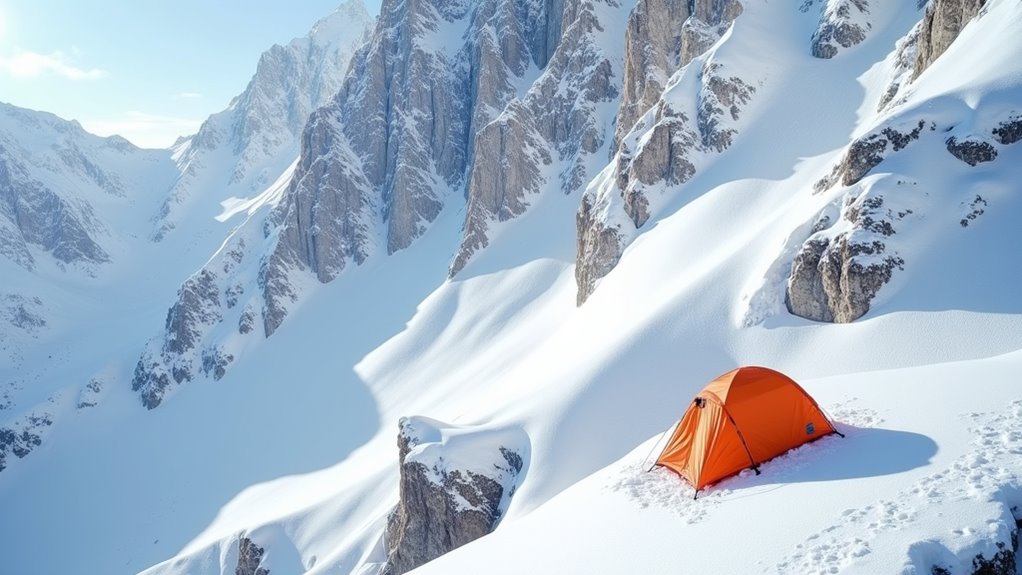
How quickly can a mountainside transform from peaceful wilderness into a deadly cascade of snow? Avalanches can occur in seconds, burying everything in their path under tons of snow moving at highway speeds.
You’ll face the highest risk on slopes between 30-45 degrees, especially after fresh snowfall or rapid temperature changes. Wind-loaded slopes and areas with obvious terrain traps like gullies or depressions are particularly dangerous.
Before entering avalanche terrain, check current avalanche forecasts and carry essential safety gear: beacon, probe, and shovel. Travel one at a time across suspect slopes, and identify safe zones before crossing.
If you’re caught in an avalanche, fight to stay on top using swimming motions and create an air pocket around your face as the snow settles.
Many winter camping enthusiasts discover that bushwalking offers excellent preparation for navigating hazardous mountain terrain safely.
While you’re bundling up against freezing temperatures, your body’s quietly losing water at an alarming rate that most winter campers never see coming. Cold air holds less moisture, so every breath you take pulls precious water from your system. You’ll lose fluids faster than you realize through respiration and increased urination in cold conditions.
Winter dehydration sneaks up because you don’t feel thirsty like you’d in summer heat. Your thirst mechanism actually decreases in cold weather, creating a dangerous blind spot.
Watch for these critical warning signs:
Drink water consistently, even when you don’t feel thirsty. Implementing proven dehydration prevention strategies becomes even more crucial in winter conditions when your body’s natural warning systems are compromised.
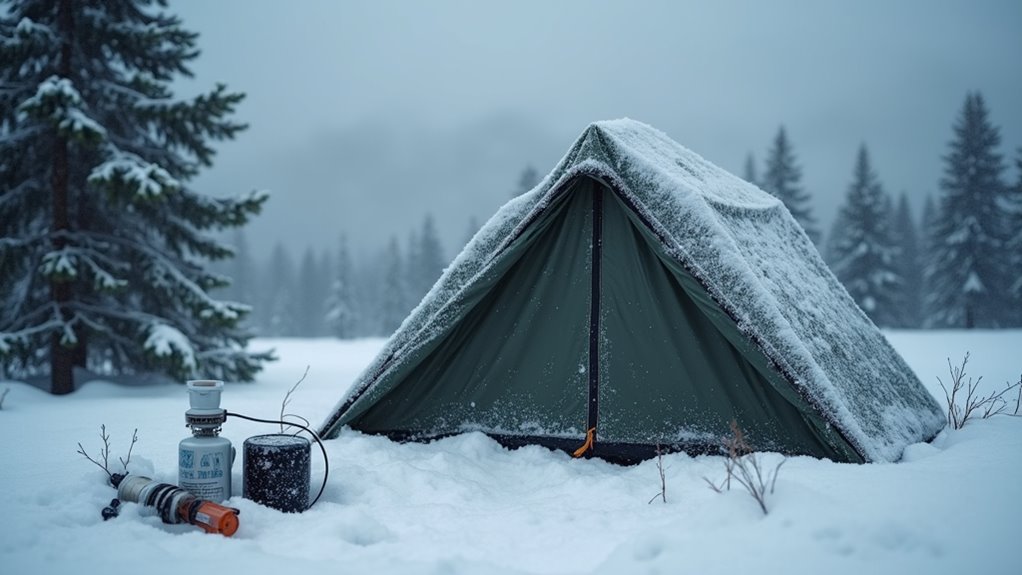
When temperatures plummet to dangerous lows, your gear faces its ultimate test—and that’s exactly when failures hit hardest.
Your sleeping bag’s zipper can freeze shut, trapping you inside. Battery-powered devices die rapidly in cold, leaving you without light or communication. Tent zippers seize up, and fabric becomes brittle enough to tear.
Water bottles and hydration systems freeze solid, making them useless. Stove fuel lines clog, preventing you from cooking or melting snow. Boot soles separate from uppers when adhesives fail.
You can’t prevent every failure, but you can prepare. Carry backup equipment for critical items. Keep batteries warm in your sleeping bag. Use petroleum jelly on zippers.
Test all gear in cold conditions before your trip. When equipment fails in winter, redundancy saves lives. While winter presents unique challenges, rainy weather creates similar gear vulnerabilities that require equally careful preparation.
Where solid ground ends and hidden ice begins, winter campers face their greatest physical threat. You’ll encounter three critical scenarios that demand your constant attention:
Your best defense isn’t courage—it’s paranoia. Test every step with trekking poles. Wear microspikes consistently, not just when conditions look obviously icy. One slip can end your trip with hypothermia, broken bones, or worse.
Modern camping equipment now includes advanced ice cleats and stabilizers specifically designed for winter conditions, providing better traction than traditional gear on unpredictable frozen surfaces.
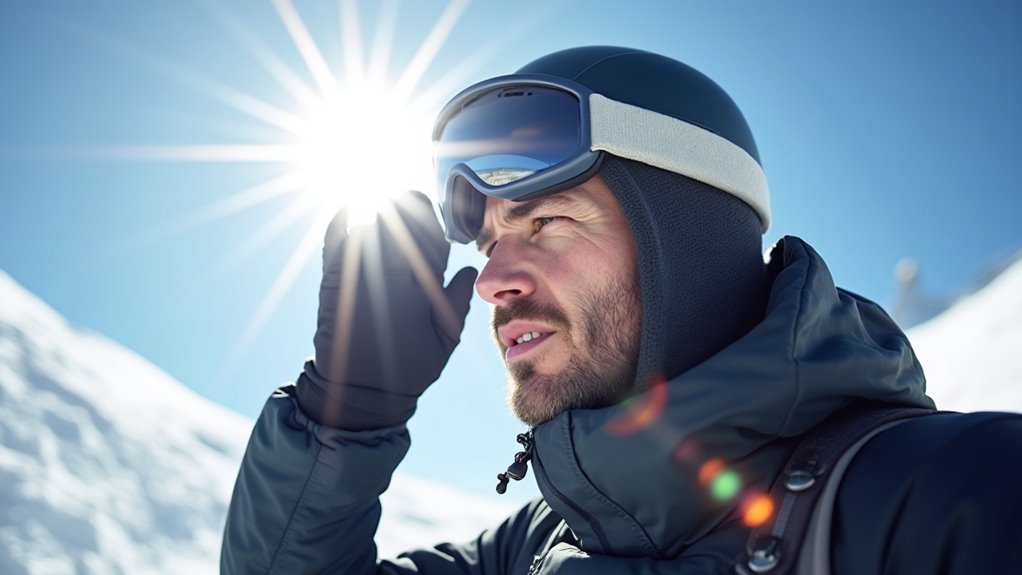
Beyond the physical dangers lurking beneath your feet, winter’s brilliant landscape poses a serious threat to your vision. Snow reflects up to 90% of UV rays, creating an intense glare that can burn your corneas within hours. You’ll experience snow blindness as a gritty, burning sensation in your eyes, followed by tearing, headaches, and temporary vision loss.
Don’t assume cloudy skies protect you—UV rays penetrate clouds easily. Always wear wraparound sunglasses with 100% UV protection, even on overcast days. Glacier glasses work best since they block light from all angles. If you’ve forgotten eye protection, create makeshift shields using cardboard with narrow slits.
Symptoms typically appear 6-12 hours after exposure. Rest in darkness and use cool compresses for relief. Most cases resolve within 24-48 hours. Just as mosquito nets provide essential barrier protection against disease-carrying insects in tropical regions, proper eye protection serves as your critical defense against UV damage in snowy environments.
As snow accumulates on your shelter throughout the night, the weight can quickly exceed what your tent or tarp was designed to handle. Heavy, wet snow poses the greatest risk, with each cubic foot weighing up to 20 pounds. When your shelter can’t support the load, catastrophic collapse threatens your safety and leaves you exposed to harsh elements.
Snow load buildup can transform your protective shelter into a deadly trap within hours of heavy precipitation.
Prevent shelter failure with these essential steps:
Your vigilance determines whether you’ll wake up warm or buried. Just as anglers weigh the benefits of renting versus buying watercraft for seasonal use, winter campers should consider whether investing in premium cold-weather gear makes sense for occasional trips.
Don’t let winter’s beauty become a wolf in sheep’s clothing. You’ve learned the ropes—now stick to them like your life depends on it, because it just might. Pack smart, stay alert, and respect Mother Nature’s icy grip. She doesn’t forgive mistakes easily. Your adventure should leave you with incredible memories, not hospital bills. Trust your gear, trust your instincts, and remember: the mountains will always be there for another day.